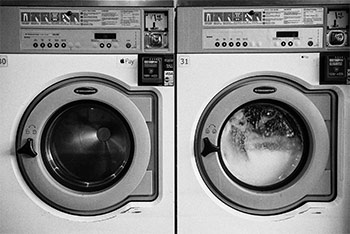Fix Your Washing Machine Without Calling an Engineer.
Posted by Vero Luxury Linens on Dec 29, 2017

There’s no doubt we all depend upon our washing machines for maintaining the luxurious freshness of our natural linens and towels. But did you know your washing machine has a life expectancy of just 11 years? And there’s a good chance you’ll encounter the occasional problem before its time is up. This can be a major inconvenience when you have a busy washing schedule and need to clean your towels every 3-4 days. But don’t despair! Our troubleshooting guide can save you time and money by helping you decipher the origins of your washer problem and possible ways to fix it. A word of warning; remember to always remove the power source from your washer before attempting to repair it.
No power
If your washer has no power, start by investigating the power supply. Check the outlet voltage with a multi-meter. If there’s a problem with the outlet, a qualified electrician should be called. If the power supply appears to be OK, check the washer’s motor which will shut down if it overheats, and also check the door lock or lid switch which must be engaged in order for the washer to start. And don’t forget to ensure the user control panel is functioning and the operating switches are aligned correctly.
Water on the floor
Surely this is the most distressing of all signs that your washing machine is malfunctioning. There are many possible problems to investigate, all of which require replacement of parts. If you have a front-load washer, first check the door seal. If this is intact, check the drain hose at the back of the washer to ensure it’s fitted securely and that there are no cracks or blockages. Also check that the drain pump isn’t damaged or jammed by a rogue sock. Make sure you look at the pump inlets too. Then check the fill hose and water-inlet valve for leaks. And lastly check the tub and tub seal - if these parts are the culprits, the repair job will be complicated and you may have to invest in a new washer.
No spinning
This can often be resolved by simply adjusting your load. If you attempt to spin a small load, the balance sensors may detect this and prevent the washer from spinning. The sensors will also activate if you try to spin too large a load - remember, one set of linen sheets per wash is the optimum. Also check the pump is draining the washer effectively, the belts are intact and the washer motor is operating correctly.
Noisy, shaking and smelly
These are unpleasant things to encounter. If you hear gurgling, this may indicate an obstruction in the drain line that needs removing. A clicking sound may be due to a foreign object lodged in the washer drain, but if it has lodged in the pump you’ll hear a buzzing or humming noise. If your machine shakes vigorously during a cycle, simply check the washer is level and the feet are correctly positioned. Also check that you haven’t overloaded the washer with linens and towels as this could cause it to go off-balance. With old models, it’s worth checking the concrete weights and shock absorbers. And if you find your washer begins to smell unpleasant, this will be due to buildup of bacteria inside the machine - a common problem with washing at low temperatures. Ensure you clean your machine once a month with bleach or white vinegar, the non-toxic, environmentally safe option.
As a side note: Vinegar has become the go to cleaner for many items, to view an interesting list of 70+ other uses for vinegar, click this link - https://www.tipsbulletin.com/vinegar/ .
Next steps
Use this guide to isolate the problem with your washer so that you can quickly resume your washing schedule and get back to fresh linens. With a bit of luck you’ll be able to rectify the problem yourself, although in some cases a technician will be needed. Just remember, usually a fault does not mean an end to your washer.

